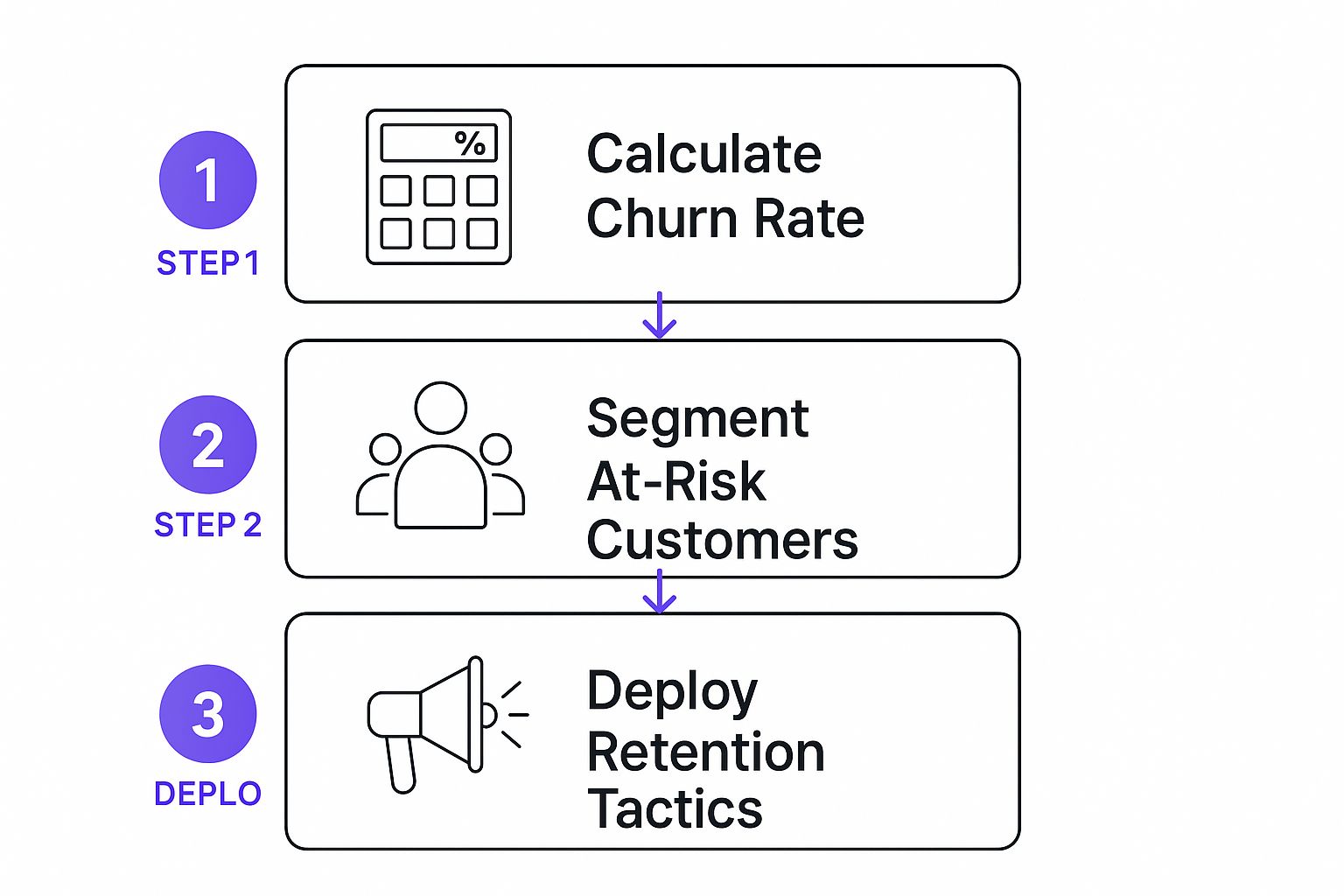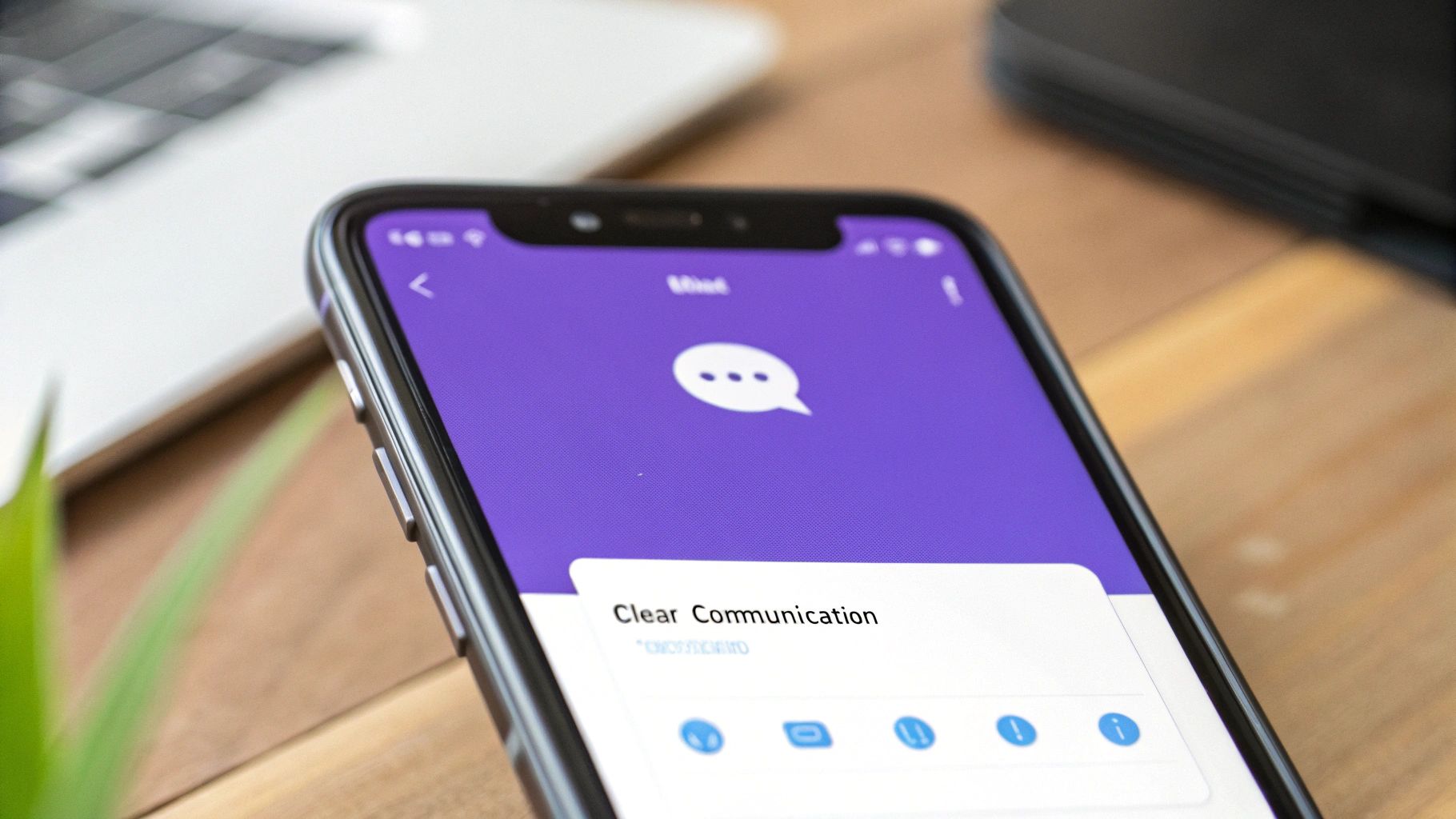
Before you can plug the leaks, you have to understand just how damaging they are. Customer churn isn't just a number on a report; it's a compounding financial drain that can quietly sink a business. A small monthly churn rate feels manageable, but it quickly erodes your customer base and revenue, forcing you into a frantic, expensive cycle of constant customer acquisition.

So many companies I've seen just track churn as a simple percentage, and in doing so, they completely underestimate its true power. They might see a 3% or 5% monthly rate and write it off as a standard cost of doing business. This mindset is dangerous because it ignores the snowball effect churn has on your long-term health and ability to grow.
Think of churn as reverse compound interest. It doesn't just subtract a few customers from your total. It actively undermines every dollar you spend on sales and marketing. Every customer who walks away represents lost recurring revenue, a relationship that soured, and a completely wasted acquisition investment. This puts your teams on a treadmill—they have to run faster and faster just to replace the customers you've lost, let alone find a way to actually grow the business.
The true picture of churn snaps into focus when you look at it annually. A monthly churn rate of 5%, which might look small on a dashboard, actually means you’re losing about 46% of your customers over the course of a year.
If that rate creeps up to 10% a month? You’re looking at an annual churn rate of over 70%. Imagine having to replace nearly your entire customer base every single year. It’s completely unsustainable.
Research into millions of cancellations reveals a critical insight: churn is often driven by practical issues like budget cuts or simply not using the product enough, not just dissatisfaction. This shows why your retention strategy must go beyond the product itself and address these real-world customer challenges.
To get a handle on this, you need to measure the other side of the coin. Understanding how to calculate retention ratio effectively gives you a clear view of who you're successfully keeping on board.
You can't convince customers to stay until you truly understand why they’re leaving in the first place. Churn isn't a single problem; it’s a symptom of deeper issues that can pop up anywhere in their journey with you. By breaking down the reasons, you can start pinpointing your own weak spots.
The table below uncovers some of the most frequent reasons customers leave and, more importantly, what those reasons often reveal about underlying business problems.
As you can see, a customer's stated reason is often just the tip of the iceberg. A complaint about price might really be a complaint about value. A "missing feature" could signal that your product development is out of touch with what your market actually needs. Digging into these root causes is the first real step toward building a business that people don't want to leave.
If you're waiting for the "I'd like to cancel" email to land in your inbox, you're already behind. The most powerful churn reduction strategies aren't built on reactive panic, but on proactive insight. It’s time to stop guessing and start building a system that gives you a real-time pulse on your customers' well-being: a customer health score.
Think of a health score as a credit score for customer loyalty. It’s a predictive metric you build by blending different signals of customer behavior into one clear rating. It tells you who’s 'healthy,' who’s 'at-risk,' and who’s in 'critical' condition—long before they even consider leaving. This lets your team step in with the right help at the right time.
It’s about shifting from a defensive scramble to a strategic, data-informed operation.
The process of identifying at-risk customers and taking action can be visualized in a simple flow.

As you can see, once you understand your churn rate and can spot at-risk groups, the real work of deploying targeted retention tactics begins.
The magic of a health score isn't in the concept, but in the data you choose to feed it. Generic metrics are useless here. You need to identify the specific signals that directly point to value and success within your business model.
Here are the essential categories I always recommend starting with:
For example, a B2B SaaS company I worked with discovered that users who set up a specific integration within their first 30 days had a staggering 90% retention rate. That single action became a critical health indicator for them. Similarly, an e-commerce brand might find that customers who join their loyalty program and make a second purchase within 60 days almost never leave.
The key is to shift your focus from lagging indicators (like exit surveys) to leading indicators (like product behavior). By the time a customer tells you they're unhappy, their mind is often already made up.
Once you’ve got your metrics, you need to assign them weights. Not all signals carry the same importance. For most businesses, deep product engagement is far more telling than the number of support tickets filed, so it should have a bigger impact on the final score.
A straightforward way to get started is with a points-based system:
Finally, you need to set your thresholds. This is what makes the score actionable. For instance, a score of 80-100 might be "healthy," 50-79 could be "at-risk," and anything below 50 is "critical." This simple segmentation becomes your team's playbook, telling them exactly where to focus their energy to stop churn before it happens.

Knowing which customers are on the verge of churning is only half the battle. Now you have to do something about it. But let's be honest, a generic "just checking in" email is probably heading straight for the trash. To actually decrease customer churn, your interventions need to be proactive and packed with genuine value.
It's less about asking "how's it going?" and more about showing up with a solution to a problem you already know they have. This simple shift can turn a potential cancellation into a moment of re-engagement, reminding them exactly why they signed on with you in the first place.
Ultimately, you’re moving from reactive fire-fighting to proactive success.
Your customer health scores and behavioral data are your cheat sheet for impactful outreach. A low score isn't just a generic red flag; it's a diagnostic tool that points to why a customer is struggling. Your response should be a direct answer to that "why."
Here are a few scenarios I've seen play out:
The best touchpoints feel less like a sales tactic and more like a partnership. You're not just trying to keep their subscription active; you're actively invested in their success and using your expertise to help them hit their goals.
This kind of personalized attention shows you're looking at their outcomes, not just their account status.
Random acts of outreach just won't scale. For your team to be truly effective, you need a playbook that maps specific behavioral triggers to pre-designed, value-packed actions. This creates consistency and empowers your team to act fast the moment a customer's health score dips.
Your playbook should clearly define the "what, when, and who" for each at-risk signal.
Of course, the first touchpoint is often the most important one. Solid customer onboarding strategies are essential for setting the right tone from day one and can dramatically influence long-term retention. By designing these thoughtful, structured interactions, you build a system that actively fights churn by proving your value again and again.
As you add more and more customers, trying to keep a personal eye on every single one becomes a recipe for burnout. At some point, you simply can't hire fast enough to keep up. This is where smart automation comes in. The goal isn't to replace your team, but to give them superpowers.
Think of it this way: automation is a force multiplier for your customer success managers. It takes the repetitive, data-heavy lifting off their plates so they can focus on what they do best—having meaningful conversations and solving the tricky problems that a machine can't. You move from a reactive, fire-fighting mode to proactively building relationships that last.
Today's AI-powered platforms are more than just fancy to-do list generators. They can dig through mountains of customer data—think product usage, support ticket history, and even the tone of emails—to spot churn risks with surprising accuracy. Some tools can even recommend the "next best action" for your team, giving them a clear, data-backed reason to reach out.
Imagine this scenario: an AI flags an account where usage of a core feature has flatlined, right around the same time they sent a frustrated-sounding email to support about billing. The system can instantly create a task for the account's CSM to investigate, arming them with all that context before they even pick up the phone.
The real magic of AI here is its ability to connect dots a human might miss. It can see faint, troublesome patterns across thousands of accounts that would be invisible if you were just looking at one customer's dashboard.
This is how you get ahead of churn without having to double your headcount every time you double your customer base.
When you spot a customer starting to drift away, you have to act fast. This is where automated workflows are your best friend. These aren't just generic email blasts; they're targeted, timely responses triggered by specific customer behaviors (or lack thereof).
You can build simple but powerful automations for common churn signals like these:
Finally, don't underestimate the power of a good chatbot. By instantly handling common questions 24/7, bots reduce customer frustration and free up your support team for the complex issues that require real empathy. It all works together to create a smarter, more efficient engine for keeping your customers happy.
Here is the rewritten section, crafted to sound human-written and natural:
If you're only starting to think about a customer's renewal a month before it's due, you're already playing from behind. A successful renewal isn’t a single event; it's the natural result of delivering consistent value throughout the entire year. The real work happens long before any paperwork ever gets signed.
Proactive engagement is everything, especially when you look at industries with sky-high churn. The wholesale sector, for example, can see churn rates climb as high as 56%. Consumer packaged goods (CPG) aren't far behind, with rates sometimes hitting 40%. These numbers, often fueled by low switching costs and fickle consumer habits, offer a critical lesson for everyone. To get ahead of it, smart companies are scheduling more frequent check-ins to gather feedback and fix problems before they become reasons to leave. If you're curious about how churn rates vary by industry, CustomerGauge has some eye-opening data.
Ultimately, this hands-on approach is fundamental for any business serious about its goal to decrease customer churn.
The renewal discussion should never feel like an ambush. It needs to feel like the next logical step in a strong partnership. Your team has to walk into that conversation armed with the customer’s health score, recent usage data, and a log of their past support tickets. This context transforms a generic "So, are you renewing?" into a meaningful, strategic dialogue.
Instead of just asking for the business, guide the conversation with value:
When a customer does decide to leave, it stings. But it's also a priceless learning opportunity. The feedback you get at this stage is pure gold—it’s unfiltered, brutally honest, and shines a spotlight on the biggest cracks in your customer experience.
The most important thing you can do with cancellation feedback is make it actionable. Don't just let it die in a spreadsheet. Create a formal process to feed these insights directly back to your product, marketing, and support teams.
For example, if several churning customers mention a missing integration, that’s a massive signal for your product team. If they complain about slow response times, that's a red flag for your support leadership. This creates a powerful cycle where every customer loss makes your company stronger and better equipped to prevent the next one. Beyond just focusing on renewals and feedback, implementing broader ecommerce customer retention strategies is a great way to fortify your business against churn across the board.

As you start putting together a plan to reduce customer churn, questions are bound to come up. We get it. Let’s walk through some of the most common ones I hear from teams just like yours.
Think of this as practical advice, not abstract theory, to help you tackle the real-world challenges of keeping your customers happy and sticking around for the long haul.
This is the million-dollar question, and the honest answer is: it depends. A "good" churn rate looks very different depending on your industry, business model, and maturity.
For a typical B2B SaaS company, a monthly churn rate between 3-5% is often seen as a healthy benchmark. If you're a more established player with a strong foothold in your market, pushing that number below 1% is a fantastic goal.
But the real holy grail? It's achieving negative churn. This is the point where the revenue you generate from existing customers (through upgrades, expansions, or add-ons) outpaces the revenue you lose from those who cancel. It’s the ultimate sign of a sustainable, healthy business.
Yesterday. But since we can't time travel, the answer is right now. Your churn reduction efforts should kick in the second a customer signs up.
A smooth, value-packed onboarding experience is your first and best chance to set the stage for a long-term relationship. Don't wait around for warning signs like a dropping health score or a complaint ticket. Retention can't be a reactive fire drill; it has to be a proactive strategy woven into every part of the customer journey, starting on day one.
While several metrics can give you hints, product engagement is usually the most reliable crystal ball. When a customer stops logging in or using the core features that solve their problems, they’re waving a massive red flag.
Of course, other indicators matter. A sudden flood of support tickets or a dismal Net Promoter Score (NPS) are definitely cause for concern. But a sharp decline in how often someone actually uses your product is the most direct signal that they’ve already started to check out mentally.
It's wild how much retention rates can vary. Media and professional services can hit 84% retention, while industries like hospitality might see rates as low as 55%. Here's a powerful stat: customers who've had great service experiences in the past spend 140% more than those who've had bad ones. That just shows the massive financial win that comes from keeping people happy. You can dig into more of these customer retention statistics and their industry-wide impact.
Yes, you absolutely can, especially when you're a smaller company where everyone wears multiple hats. The key is to distribute the responsibility.
Here’s how it can work in practice:
The secret isn’t a fancy job title; it's a shared mindset. When everyone in the company feels a sense of ownership over the customer experience, retention becomes a natural result of doing business well.
Ready to turn customer data into your strongest retention tool? Statisfy uses AI to automate data analysis and generate actionable insights, freeing your team to build the relationships that stop churn. Discover how Statisfy can help you build a more proactive customer success strategy.